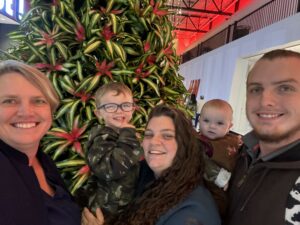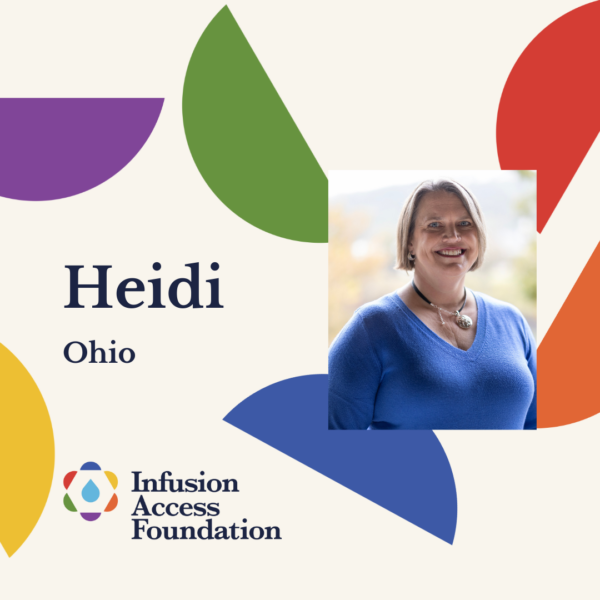I was diagnosed with a primary immune deficiency disorder in 1980, before anyone knew much at all about immune deficiencies. A man from my small town spent time at the NIH and received a diagnosis. As luck would have it, my mom was a huge advocate for me, and on hearing the story of this man’s health experience pushed my doctors to test me as well.
Learning What the System Didn’t Know
While many of my doctors didn’t yet know what an immune deficiency was, David Vetter, the “Boy in the Bubble”, helped bring awareness, and my mom went to bed at night reading medical texts so she could educate my medical team. Then, the AIDS epidemic caused a new level of fear.
In my adulthood, lifetime maximums and insurance policies limiting access to IVIG caused mental and physical struggles. Ear infections caused hearing loss, chronic bronchitis, and pneumonia lead to chronic obstructive pulmonary disease (COPD), and overuse of antibiotics caused painful tooth and stomach symptoms.

Two Generations, Same Fight: Accessing Care
My illness also made it difficult to work and pursue professional goals. I was interested in education, healthcare, and careers that would help others. The burden of being sick all the time led me to default to becoming an insurance agent. I had to decide between a corporate job with good benefits and a small agency with flexibility, so I didn’t get fired for missing too many days to manage my health and my son’s health. Ultimately, I chose flexibility and opted not to use immunoglobulin replacement, allowing me to maintain my eligibility for small group health plans. My ex-husband’s corporate policy covered my son, and therefore, he started infusions in 2006. However, we still faced uphill battles every six months for prior authorizations.
The Affordable Care Act (ACA) eliminated insurance eligibility issues and lifetime maximums; however, individual plans became unaffordable very quickly. New access barriers, such as copay accumulators and step therapy, emerged and posed new threats.
My son and I had several years where I had to decide who could receive treatment because I could fit one deductible into the budget, but not two. Of course, my son always came out on top. My son spent a year off of his therapy in 2023 because step therapy forced him off the product he’d been on for five years. While trying the alternative therapies that were covered, it triggered an autoimmune response to dairy and soy, and he now has anaphylactic reactions if his food is contaminated, when he previously had no allergies at all. Once the company updated its list to include his product, he discovered that they would no longer assist him. He is a young father of three, and he and his wife are both on plasma-based therapies. Since his preferred medication was covered, copay accumulators were being applied to his policy, meaning he would need to come up with $10,000 to pay his respective individual deductible before his insurance company would allow the next dose of his medication to be shipped. With three children to feed, they have decided to go off therapy, and have been battling illness and missed time at work. We are hoping they don’t get exposed to anything that will land them and their children in the hospital while they are off their life-giving medications.

From Avoiding Illness to Advancing Policy
On therapy, I was able to go back to school to finally fulfill my dream of entering the helping professions. I got a nursing degree in 2020 at the age of 43. However, it was 2020, and a global pandemic was underway. In ways, it was like the rest of the world finally knew what it was like to be me. When someone coughed in a room, I was no longer the only one with internal alarms going off, telling me to get away from that person immediately. Now, everyone in the room gave them six feet or more. But it was also very scary. I was now starting a career in healthcare while my immunodeficient peers were dying in record numbers. Not the old ones — the ones my age and younger. I took a job in the oncology intensive care unit (ICU) at our local teaching hospital and felt relatively safe for a few months. Then, they announced that our floor would begin accepting COVID-19 patients. I was forced to quit my job and reinvent my life—again!
I went back to school and then decided that, since I was on plasma-based infusions, I wanted to try working in the plasma industry — specifically with healthy donors instead of sick patients. It was there that I found my passion. I was now not only on the front lines of helping to ensure plasma was safe for the millions of patients that rely on it for their treatments, but I was also able to help donors put a face on their donation and see firsthand what a difference they were making in my life. I have expanded my legislative advocacy work to include not only primary immune deficiencies but also all patients with rare diseases, particularly those who rely on plasma-based therapies. By expanding insurance policies and governmental protections of coverage, I can help ensure that others never have to make the same choice I did, which family member is deserving of therapy this year. Or should I quit my job and get divorced so I qualify for Medicaid?
I am not only advocating for my family, but I am also able to keep up with my three beautiful grandchildren and travel around the world to places such as Cambodia on medical missions. Plasma donors have given me my life back, and I intend to continue fighting for insurance protections and patient safety not only for my family, but for every rare disease patient.
Access to treatment isn’t just about staying alive; it’s about living a better life. It’s about being able to care for your children, pursue your purpose, and protect the next generation. At the Infusion Access Foundation, we’re working to change the policies that make patients choose between their health and their future. No one should have to fight this hard to access care, and sacrifice dreams to get the care they deserve. Heidi Plavecsky wrote this story. The Infusion Access Foundation team wrote this story.






